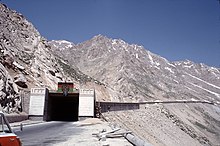살랑터널
Salang Tunnel35°19'19.″N 69°1'37.0 ″E/35.322083°N 69.026944°E


살랑 터널 (다리: تونل سالنگ 투넬에 살랑, 파슈토: د سالنگ تونل 다 살랑 투넬)은 아프가니스탄의 수도 카불에서 북쪽으로 약 90km 떨어진 파르완 주와 바그란 주 사이의 힌두쿠시 산맥의 살랑 고개에 위치한 2.67km (1.66m) 길이의 터널입니다.해발 약 3,200 미터 (10,500 피트) 높이에 있는 그것은 1964년 소련에 의해 완성되었고 아프가니스탄 북부와 수도 카불, 그리고 그 나라의 남부 지역을 연결합니다.살랑 터널은 전략적으로 중요한[1] 곳이며, 비록 폭설로 인해 추운 겨울 동안 종종 폐쇄되지만, 남북 방향으로 가는 유일한 통로입니다.[2]
개요

터널은 아프가니스탄의 주요 남북 연결을 나타내며, 이동 시간을 72시간에서 10시간으로 단축하고 약 300km (190마일)를 절약합니다.그것은 약 3,400 미터 (11,200 피트)의 고도에 이르고 길이는 2.6 킬로미터 (1.6 마일)입니다.터널 튜브의 폭과 높이는 7미터(23피트)입니다.다른 소식통에 따르면 터널은 바닥의 폭이 6.1미터(20피트), 높이가 4.9미터(16피트)를 넘지 않지만 중앙에만 있다고 합니다.[3]
2010년에 매일 약 16,000대의 차량이 살랑 터널을 통과하는 것으로 알려졌습니다.[4]다른 보도에 따르면 이 터널은 하루에 1,000대의 차량을 위해 설계되었으나 현재는 하루에 7대에서 1만대의 차량을 처리하고 있습니다.[3]
역사

1955년 아프가니스탄과 소련은 역사적인 살랑 고개를 통해 살랑 도로의 공동 개발을 시작하기로 합의했습니다.그 터널은 1964년에 개통되었고 북부 지역에서 카불까지 연중 내내 연결되었습니다.이 터널은 1973년 미국이 로키 산맥의 콜로라도에 약간 더 높고 약간 더 긴 아이젠하워 터널을 건설하기 전까지 세계에서 가장 높은 도로 터널이었습니다.
환기장치는 1976년에 만들어졌습니다.
소련-아프간 전쟁 동안, 터널은 남쪽으로의 중요한 군사적 연결이었지만, 아프간 무자헤딘 전투기들에 의해 매복 공격을 받기 쉬웠습니다.
1989년 소련이 아프가니스탄에서 철수한 후, 유지보수에 어려움을 겪었고, 결국 1997년부터 1998년까지 북부동맹군과 탈레반 간의 전투 과정에서 터널의 입구, 조명 및 환기 시스템이 파괴되어 어둠 속에서 걸어서만 이동할 수 있었습니다.2001년 미국의 아프가니스탄 침공으로 탈레반이 이끄는 정부가 전복된 후, 아프가니스탄, 프랑스, 러시아, 미국 등의 기관들이 공동으로 지뢰와 잔해를 치우고 2002년 1월 19일 터널을 다시 열었습니다.[2]
2010년대 초에도 ISAF로부터 수리 및 개조 자금을 지원받고 있었습니다.[5]
2012년 미국 국제개발처(USAID)는 현재의 터널보다 더 먼 힌두쿠시 산맥을 지나 파완주 올랑 지역(남쪽 약 6km)에서 바글란주 도샤크(북쪽 약 10km)에 이르는 새로운 터널에 대한 기술적 연구를 진행했습니다.이동 거리를 30~40km(19~25m)[6] 단축시킨 디자인.
인시던트
1980년 사고
1980년 2월 23일 도로교통사고로 소련군 호송차량이 갇히고 군인 16명이 배기가스에 질식했습니다.[7]
1982년 화재

1982년 11월 3일 치명적인 화재로 소련군 64명과 아프간인 112명이 사망했습니다. 충돌 후 유조선 트럭이 터널에서 폭발했고 화재는 군 호송차량을 집어삼켰습니다.서방의 자료에 따르면 사망자는 2,700명에서 3,000명에 이를 것으로 추정하고 있습니다.
2002년 눈사태
재개장한 지 몇 주 만에 수백 명의 사람들이 남쪽 끝의 눈사태로 인해 터널에 갇혔습니다.대부분의 사람들이 구조된 반면 일부 사람들은 질식과 냉동으로 사망했습니다.2004년 7월에 추가적인 재활을 거친 후, 그 터널은 양방향 교통을 운반할 수 있었습니다.
2009년 눈사태
2009년 1월 터널 접근로에서 발생한 눈사태로 최소 10명이 사망했습니다.[8]
2010년 눈사태
2010년 2월 8일, 터널 주변 지역에 최소 17건의 눈사태가 잇따라 발생해 수 마일에 이르는 도로가 매몰되고 175명이 사망하고 수백 명이 발이 묶였습니다.[9][10][11][12]수백 대의 자동차가 눈 속에 파묻혔습니다.[10]최소 400명의 부상자가 발생한 것으로 알려졌습니다.[13]
아프간 국군과 나토는 헬기를 이용해 차량 안에 갇힌 최소 2,500명을 구조했습니다.[10]
이번 눈사태는 지역을 강타한 갑작스러운 눈보라로 터널과 터널 양쪽 주변 도로가 폐쇄되면서 발생했습니다.[9]
이 터널은 2010년 2월 12일에 다시 개통되었습니다.
2022년 화재
2022년 12월 18일, 연료 탱크가 폭발하여 최소 31명이 사망하고 37명이 부상을 입었습니다.[14][15]
참고 항목
참고문헌
- ^ "Salang Tunnel - Afghanistan's lifeline". BBC. 10 February 2010. Archived from the original on 2013-03-06. Retrieved 2023-02-11.
- ^ a b Jerome Starkey (9 February 2010). "Avalanches kill 28 and injure dozens near Salang tunnel". The Times. Archived from the original on 2011-06-04. Retrieved 9 February 2010.
- ^ a b Nordland, Rod (2012-06-02). "U.S.-Pakistan dispute chokes Afghan supply route". The Seattle Times. Archived from the original on 2016-04-01. Retrieved 2012-06-04.
- ^ IRINnews (February 15, 2010). "Lessons from the Salang pass disaster". Retrieved March 7, 2010.
{{cite web}}: CS1 유지 : url-status (링크) - ^ "ISAF finance Salang tunnel renovation". The Khaama Press News Agency. 2 March 2013. Archived from the original on 2013-03-04. Retrieved 3 December 2017.
- ^ "Technical Studies for New Salang Tunnel Underway". Archived from the original on 2012-04-29. Retrieved 2012-04-27.
- ^ "Афганистан". Archived from the original on 2008-05-11. Retrieved 2021-08-24.
- ^ "Afghanistan avalanches kill 10". The Belfast Telegraph. 2009-01-18. Archived from the original on 2016-08-01. Retrieved 2009-01-18.
- ^ a b "Afghanistan tunnel avalanches kill 24 in Hindu Kush". BBC News. 9 February 2010. Archived from the original on 2010-02-11. Retrieved 9 February 2010.
- ^ a b c Rod Norland (2010-02-09). "Avalanches Kill Dozens on Mountain Highway in Afghanistan". The New York Times. Archived from the original on 2010-02-19. Retrieved 2010-02-10.
Heavy winds and rain set off 17 avalanches that buried more than two miles of highway at a high-altitude pass in the Hindu Kush mountain range, entombing hundreds of cars and cutting off Kabul's heavily traveled link to northern Afghanistan, officials said Tuesday.
- ^ Faiez, Rahim (2010-02-09). "Avalanches swamp Afghan pass: Scores of bodies pulled from cars as coalition joins search for injured". Toronto Star. Archived from the original on 2016-03-06. Retrieved 2010-02-10.
A series of avalanches engulfed a mountain pass in Afghanistan, trapping hundreds of people in their buried cars and killing at least 24 people, authorities said Tuesday.
- ^ Ahmed Hanayesh, Ron Synovitz (2010-02-10). "From Afghan Avalanche, Tales Of Tragedy And Survival". Radio Free Europe. Archived from the original on 2010-02-12. Retrieved 2010-02-10.
By the evening of February 10, authorities had recovered the bodies of more than 160 victims buried by a series of avalanches. The stories told to RFE/RL by survivors suggest the death toll could rise as search teams continue their work—and when the spring thaw reveals the full extent of the tragedy. The first avalanche blocked the highway just south of the Salang Tunnel. As the traffic began to pile up, travelers in cars, trucks, and buses found themselves trapped in a deadly avalanche zone. Then, one after another, as many as 16 more avalanches wiped their vehicles off the road.
- ^ "Officials: Afghan avalanches may have killed over 60". Toronto Sun. 9 February 2010. Retrieved 9 February 2010.
- ^ "12 killed as oil tanker catches fire in Afghanistan's Salang pass". Brecorder. 2022-12-18. Archived from the original on 2022-12-18. Retrieved 2022-12-19.
- ^ Binesh, Banafsha (19 December 2022). "Death Toll in Salang Tunnel Fire Increases to 31; Casualties May Rise". Tolo News. Archived from the original on 2022-12-20. Retrieved 2023-02-11.
외부 링크
 Wikimedia Commons의 Salang Tunnel 관련 매체
Wikimedia Commons의 Salang Tunnel 관련 매체


